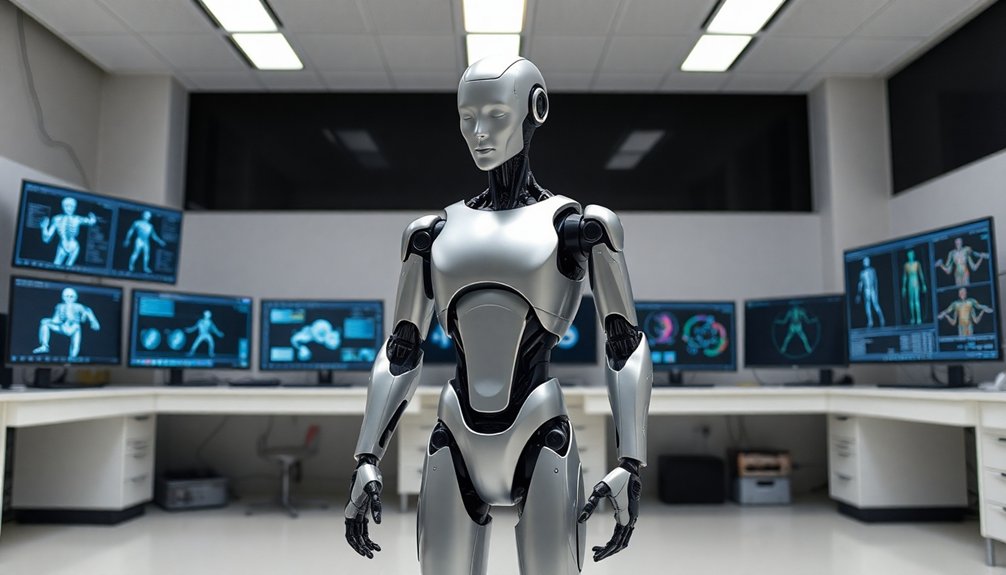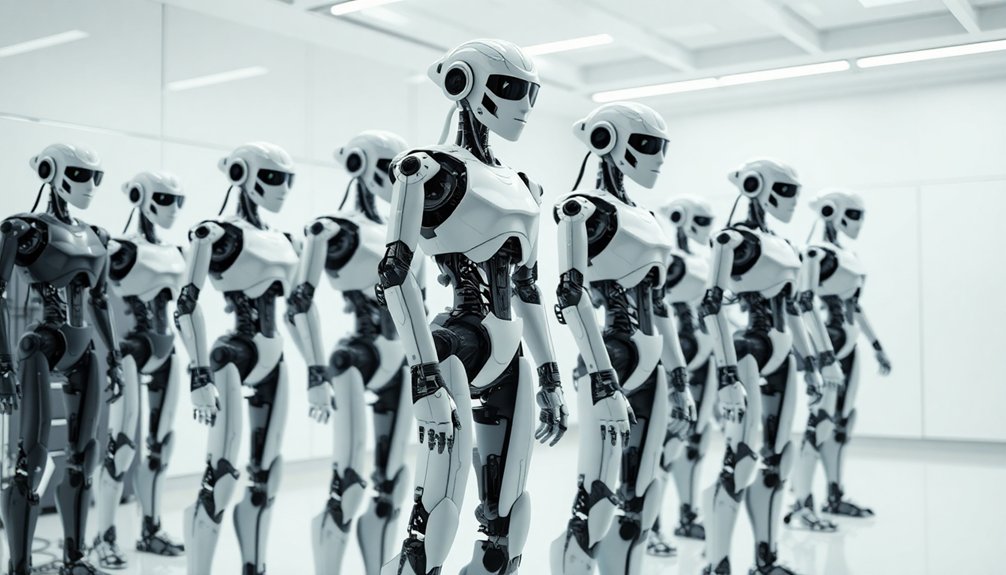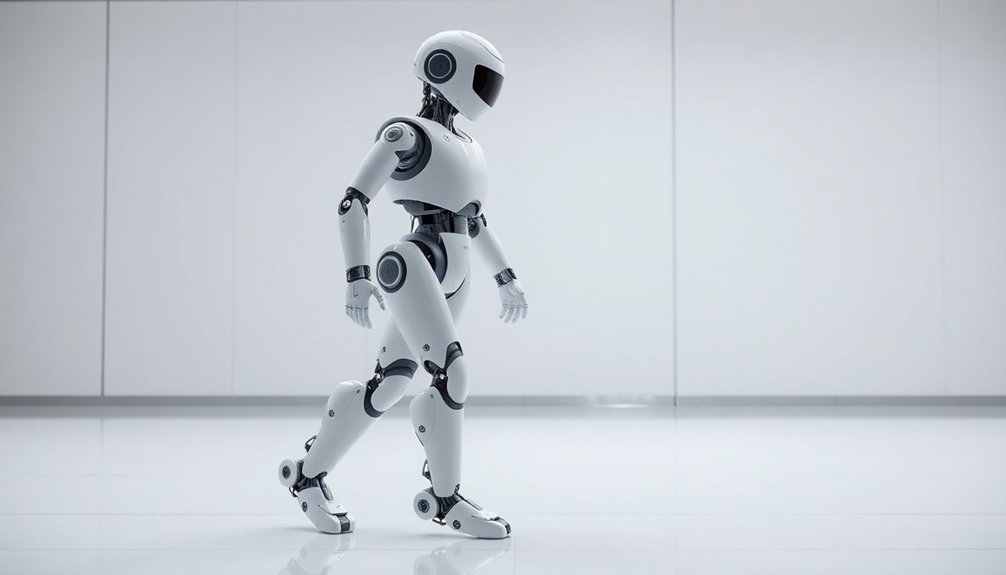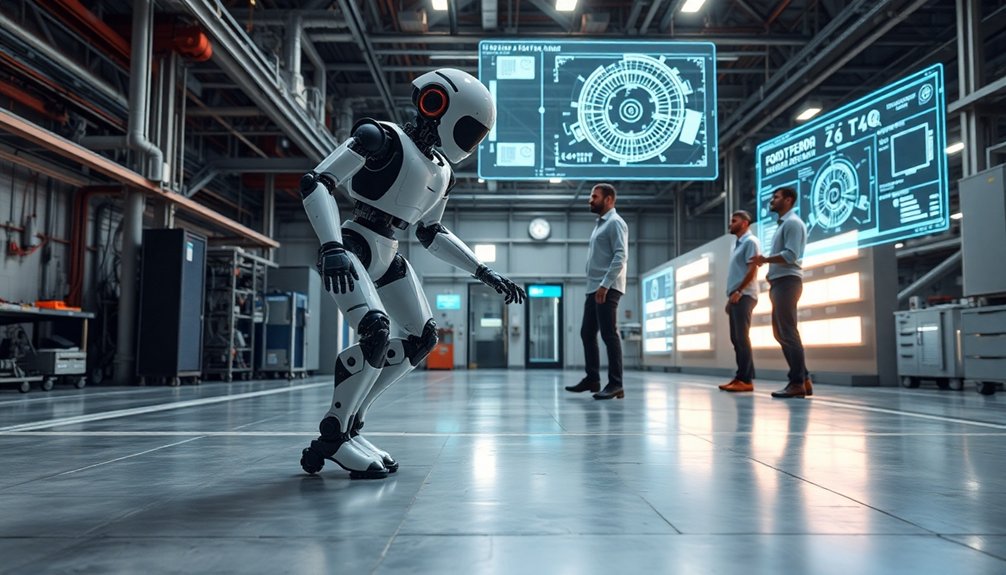A humanoid robot is a cutting-edge machine that looks and acts like a human, using advanced sensors, artificial intelligence, and sophisticated engineering. You’ll find these robots performing complex tasks in manufacturing, healthcare, and research, mimicking human movements and interactions. They’re designed to learn, adapt, and solve problems autonomously. Their incredible technology combines robotics, machine learning, and human-like perception, offering a glimpse into our technological future. Curious about what’s next?
What Defines a Humanoid Robot

Imagine a machine that moves, thinks, and interacts like a human—welcome to the fascinating world of humanoid robots.
These advanced humanoid robots are designed to look and behave remarkably similar to humans, featuring a torso, head, arms, and legs that enable human-like movements. By incorporating sophisticated sensors and artificial intelligence, they can perceive their environment, make complex decisions, and adapt to different situations.
You’ll find these remarkable machines can mimic human capabilities across various domains, from performing delicate tasks in manufacturing to traversing human-designed spaces with incredible precision. Their intricate actuators replicate muscle and joint movements, allowing them to interact with tools and environments just as you would. In 2025, humanoid robots are increasingly sought after for education and research as they play pivotal roles in advancing technology and AI.
Ultimately, humanoid robots represent a groundbreaking intersection of engineering, design, and intelligent technology.
Key Features of Humanoid Technology
While humanoid robots might seem like science fiction, they’re rapidly becoming a tangible technological reality. These advanced machines combine sophisticated control systems with bipedal movement, creating robots that closely mimic human appearance and behavior. Their ability to perform tasks autonomously makes them increasingly valuable across various industries. Additionally, companies like FuturoBots provide comprehensive management of sourcing and delivery processes for those looking to invest in humanoid technology.
| Feature | Technology | Capability |
|---|---|---|
| Sensory | Cameras/Sensors | Environmental Interaction |
| AI | Machine Learning | Task Adaptation |
| Mobility | Actuator Systems | Complex Movement |
| Perception | Emotion Recognition | Social Engagement |
| Intelligence | Neural Networks | Autonomous Decision-Making |
You’ll find humanoid robots are more than just mechanical devices; they’re intelligent systems designed to understand and interact with humans. By integrating advanced AI and precise engineering, these robots represent a groundbreaking frontier in technological innovation, promising exciting possibilities for our future.
Types of Humanoid Robots

Because technological innovation continues to push boundaries, humanoid robots have diversified into fascinating categories that serve distinct purposes across different environments.
You’ll find leg-based humanoids excel in maneuvering complex terrains, mimicking human movement with remarkable precision. Bipedal robots replicate human balance, making them ideal for tasks requiring natural locomotion.
If you’re interested in versatility, quadrupedal hybrids combine stability with a humanoid upper body, expanding their potential in robotics and automation. Hybrid platforms offer even more flexibility, merging wheel-based mobility with a humanoid design that can seamlessly shift between indoor and outdoor spaces.
Each robot is designed to address specific challenges, whether it’s traversing uneven ground, performing intricate tasks, or adapting to dynamic environments.
These innovations showcase the incredible potential of modern robotic technologies.
Main Applications in Various Industries
As technological advancements continue to reshape industries, humanoid robots have emerged as transformative tools across diverse sectors. These sophisticated machines are revolutionizing workplaces by enhancing efficiency, safety, and capabilities in multiple domains.
| Industry | Key Applications |
|---|---|
| Manufacturing | Assembly, material handling |
| Healthcare | Patient care, surgical support |
| Education | Interactive learning, robotics training |
| Research | Space exploration, scientific missions |
| Customer Service | Interactive assistance, companion roles |
Humanoid robots aren’t just futuristic concepts; they’re practical solutions for complex challenges. You’ll find them performing delicate tasks in industrial settings, supporting medical professionals, and even serving as educational tools. From research laboratories to consumer environments, these intelligent machines are expanding human potential, offering unprecedented opportunities for innovation and problem-solving across various professional landscapes.
How Humanoid Robots Work

Since the dawn of robotics, engineers have been perfecting the intricate mechanisms that bring humanoid robots to life. These sophisticated machines leverage artificial intelligence to autonomously navigate and interact with their environment.
You’ll find that humanoid robots are powered by advanced actuators that replicate human muscle movements, allowing them to walk, grasp objects, and perform complex tasks with remarkable precision.
High-definition sensors like cameras and microphones enable these robots to perceive their surroundings, while onboard computing systems process sensory inputs in real-time. They can learn and adapt through extensive training in simulated environments that mirror real-world challenges.
Benefits and Potential Impact
While technological innovation continues to reshape our world, humanoid robots are emerging as transformative solutions across multiple domains.
These advanced collaborative robots can handle human tasks with high efficiency, offering personalized assistance in various settings.
You’ll find them enhancing productivity in manufacturing, providing support in healthcare, and even assisting elderly individuals with daily activities.
Challenges in Humanoid Robotics Development

Despite remarkable technological advancements, humanoid robotics faces numerous complex challenges that researchers and engineers must navigate.
You’ll find that developing these sophisticated machines requires overcoming significant engineering efforts, such as gathering accurate training data and designing lightweight yet powerful systems.
Synthetic data can help, but it often leads to adaptability issues when robots encounter real-world scenarios. Control systems must be intricate enough to manage bipedal movement, which demands precise balance and coordination.
Additionally, ethical concerns loom large, with potential job displacement raising questions about humanoid robots’ societal impact.
Engineers continue to push boundaries, developing more nuanced technologies that can potentially integrate seamlessly into human environments, while carefully addressing the technical and social complexities inherent in this groundbreaking field.
Future Perspectives and Emerging Technologies
As humanoid robotics continues to push technological boundaries, the future of these remarkable machines looks increasingly promising and transformative. You’ll witness exciting advancements in artificial intelligence, mobility, and sensory systems that will revolutionize how humanoid robots interact with our world. They’ll become more autonomous, adaptive, and capable of complex tasks.
| Emerging Technology | Potential Impact |
|---|---|
| Advanced AI | Enhanced decision-making |
| Lightweight Materials | Improved robot mobility |
| Integrated Sensors | Better environmental interaction |
| Collaborative Design | Expanded human-robot cooperation |
With emerging technologies, these robots will increasingly operate in collaborative environments, guided by robust ethical guidelines. You’ll see them assisting in healthcare, education, and industrial settings, transforming how we perceive and interact with robotic technology. These advancements promise a future where humanoid robots become valuable, intelligent companions in our daily lives.
Final Thoughts
Humanoid robots are revolutionizing technology, promising incredible advancements across industries. You’ll witness remarkable transformations as these intelligent machines become more sophisticated and integrated into our daily lives. While challenges remain, the potential for innovation is immense. Embrace this technological frontier, stay curious, and be prepared for a future where human-like robots will reshape how we work, learn, and interact with the world around us.